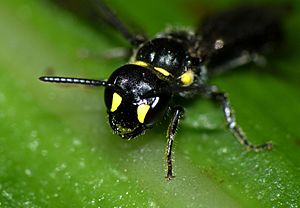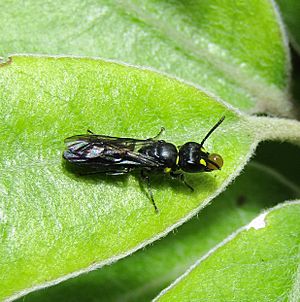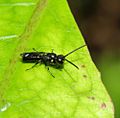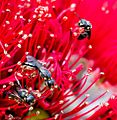Hylaeus agilis facts for kids
Quick facts for kids Hylaeus agilis |
|
|---|---|
 |
|
| Female | |
| Scientific classification | |
| Synonyms | |
|
The Agile masked bee, also known as Hylaeus agilis, is a special type of bee found only in New Zealand. It belongs to the bee family called Colletidae. These busy bees visit many different kinds of flowers. They help pollinate both native New Zealand plants and those brought from other places.
Contents
Discovering the Agile Masked Bee
Scientists give every living thing a unique name. The Agile masked bee was first described by a scientist named Frederick Smith in 1876. He originally called it Prosopis agilis. The very first specimen of this bee, called a 'holotype', is kept safe at the Natural History Museum, London. This helps scientists study the bee for years to come!
What Does the Agile Masked Bee Look Like?
H. agilis bees are quite slender and mostly black in color. They have bright yellow or white markings on their faces. These bees are not very hairy and usually measure between 7 and 9 millimeters long. Unlike most bees, Hylaeus bees do not have special hairs (scopa) on their bodies to carry pollen. Because of this, they can sometimes look a lot like wasps!
Where Do Agile Masked Bees Live?
The Agile masked bee is endemic to New Zealand. This means you can only find it there! They live on the North, South, and Stewart Islands, as well as on Three Kings Island. You can find H. agilis mainly in areas with lots of plants. They live from sea level all the way up to 1590 meters high.
Agile Masked Bee Behaviour
Adult female Agile masked bees are active from October to May. The adult males of this species can be seen flying around from October to April.
H. agilis bees are very important for pollinating red mistletoe (Peraxilla tetrapetala). This mistletoe is an endangered plant that is also found only in New Zealand. Red mistletoe flowers are 'explosive', meaning they need to be opened with force. People used to think only native New Zealand birds could twist these flowers open. However, scientists observed H. agilis bees continuously chewing on the unopened buds until they popped open! This shows how important H. agilis is for native New Zealand plants.
Since H. agilis bees don't have pollen-carrying hairs, they carry pollen inside their bodies in a special stomach called a crop. They later bring this pollen back up to feed their young. Like most bees native to New Zealand, they are solitary mining bees. This means they live alone and don't build big hives. Instead of digging their own nests, they often live in empty tunnels in branches or twigs. They also use old beetle holes found in logs.
What Plants Do Agile Masked Bees Visit?
This bee species visits a wide variety of plants. They visit both native New Zealand plants and those that have been introduced from other countries.
Native plants they visit include:
- Olearia angustifolia
- Carmichaelia species
- Peraxilla tetrapetala
- Leptospermum scoparium
- Metrosideros excelsa
- Metrosideros robusta
- Hebe salicifolia
Images for kids




